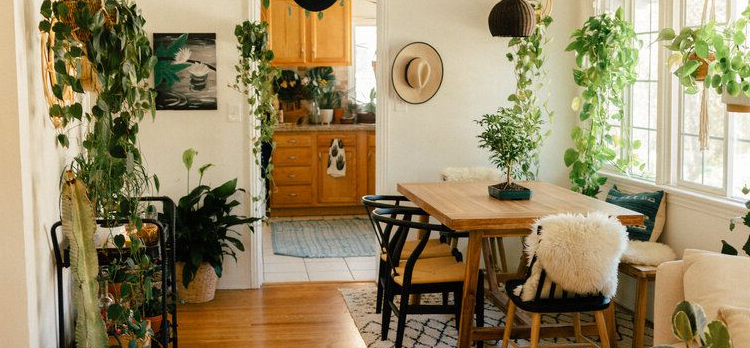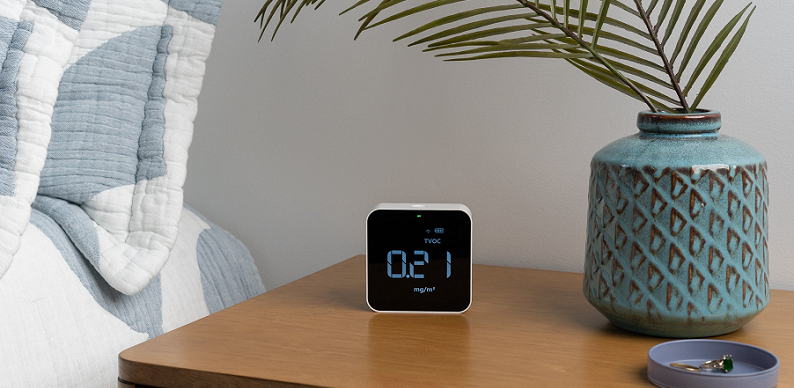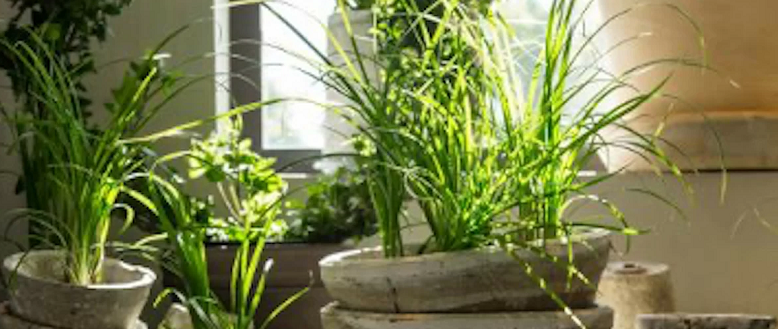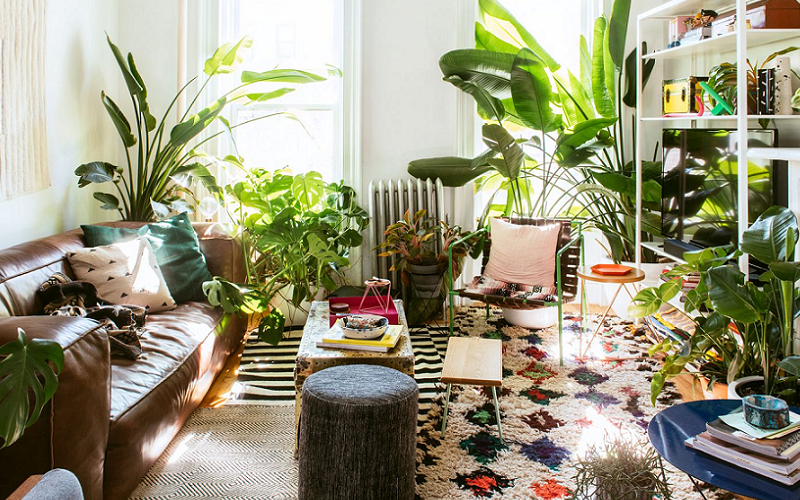Having a cozy living space is crucial and involves various aspects such as temperature, humidity, air quality, acoustics, window view, etc. It is crucial not to overlook the impact a garden can have on the home’s ambiance. Plants are more significant in our lives than we realize, regardless of our interest in gardening.
Plants and Thermal Comfort
Plants can play a significant role in providing thermal comfort in a living environment. The process of water evaporation from the leaves of plants, known as evapotranspiration, cools the air around them, making the surrounding environment more comfortable. Plants can also provide shade, which reduces the amount of direct sunlight entering a room and lowers the temperature. Additionally, plants release moisture into the air through transpiration, which can increase the humidity level and make the air feel cooler. Plants can help provide thermal comfort in several ways:
- Evapotranspiration: The process of water evaporation from the leaves of plants cools the air around them, providing a cooling effect on the surrounding environment.
- Shade: Plants can provide shade, which can reduce the amount of direct sunlight entering a room and thus lower the temperature.
- Humidity: Plants release moisture into the air through the process of transpiration, which can help increase the humidity level and make the air feel cooler and more comfortable.
- Air Purification: Plants can also help improve air quality by removing harmful pollutants, which can contribute to a more comfortable indoor environment.

Plants and Air Quality
Plants play a crucial role in improving indoor air quality by removing harmful pollutants and producing oxygen.
Phytoremediation
Phytoremediation is the process by which plants remove harmful pollutants from the air. This is achieved through the plant’s natural ability to absorb and break down certain toxic substances. These harmful pollutants, such as volatile organic compounds (VOCs), formaldehyde, benzene, and nitrogen dioxide, are taken in by the plant’s leaves, stems, and roots and then processed by the plant’s metabolic system. Some of the substances are broken down and used as nutrients by the plant, while others are expelled into the air in a less harmful form.
The process of phytoremediation helps to improve indoor air quality by reducing the concentration of harmful pollutants in the air. In addition, the process of photosynthesis, which takes place in plants, helps to balance the air quality in the indoor environment by taking in carbon dioxide and releasing oxygen. This can help to mitigate the effects of indoor air pollution, which can cause health problems such as respiratory problems, headaches, and eye irritation.

Photosynthesis
Photosynthesis is the process by which plants produce their own food and create oxygen through the conversion of sunlight, carbon dioxide, and water. This process has a significant impact on the indoor air quality by helping to balance the air quality in the environment.
Plants absorb carbon dioxide through their leaves and use the energy from sunlight to convert it into food. As a result of this process, plants release oxygen into the air. This helps to improve the air quality by reducing the concentration of carbon dioxide and increasing the concentration of oxygen. The release of oxygen can help to mitigate the effects of indoor air pollution, which can cause health problems such as respiratory problems, headaches, and eye irritation.
In addition to its role in producing oxygen, photosynthesis also helps to improve indoor air quality by reducing the concentration of certain harmful pollutants. For example, studies have shown that plants can help to remove certain volatile organic compounds (VOCs) from the air.
Microbial Activity
Plant microbial activity refers to the interactions between plants and the microorganisms that live on and around them. This activity can have a positive impact on indoor air quality by breaking down harmful pollutants and improving the overall health of the indoor environment.
Plants provide habitats for beneficial microorganisms, such as bacteria and fungi, which can help to break down harmful pollutants in the air. For example, some bacteria and fungi can break down volatile organic compounds (VOCs), which are toxic chemicals that can be found in paints, cleaning products, and other household items. By breaking down these harmful pollutants, plant microbial activity can help to improve indoor air quality and reduce the concentration of harmful substances in the air.
In addition, plant microbial activity can also improve indoor air quality by promoting the growth of other beneficial microorganisms. For example, certain microorganisms can help to control mold growth, which can cause health problems for people who are sensitive to mold.
Humidity Regulation
Plant humidity regulation refers to the ability of plants to regulate the humidity levels in the indoor environment. This process can have a positive impact on indoor air quality by helping to maintain a comfortable and healthy indoor environment.
Plants release water vapor through a process called transpiration, which helps to regulate the humidity levels in the indoor environment. When the air is too dry, plants will release more water vapor, increasing the humidity levels. Conversely, when the air is too humid, plants will release less water vapor, reducing the humidity levels.
Maintaining the right level of humidity is important for indoor air quality because it helps to prevent health problems such as dry skin, respiratory problems, and the growth of harmful mold and bacteria. In addition, low humidity levels can also increase the concentration of certain harmful pollutants in the air, such as volatile organic compounds (VOCs).

Natural Filters
Plant natural filters refer to the ability of plants to naturally remove pollutants and improve air quality. This process can have a positive impact on indoor air quality by helping to create a healthier and more comfortable living space.
Plants act as natural filters by absorbing and removing pollutants from the air through their leaves and roots. For example, studies have shown that certain plants can remove volatile organic compounds (VOCs) and other harmful pollutants from the air. The process by which plants remove pollutants is called phytoremediation, and it involves the use of plants to remove, degrade, or detoxify pollutants in the environment.
In addition to removing pollutants, plants also release oxygen and help to regulate the humidity levels in the indoor environment, both of which can help to improve air quality.
Plants and Acoustic Comfort
Plants can help to improve acoustic comfort by reducing noise levels and creating a more peaceful and calming indoor environment. This is important because high levels of noise can cause stress, affect sleep quality, and have other negative impacts on health.
Plants can act as natural sound absorbers by absorbing sound waves and reducing the amount of noise that is reflected back into the environment. The leaves, stems, and branches of plants can act as natural sound baffles, which are materials that are used to reduce the amount of noise that is reflected back into the environment.
In addition to absorbing sound, plants can also help to create a peaceful and calming environment by visually reducing the impact of noise. For example, a well-planted room can make a space feel quieter and more peaceful by reducing the visual impact of noise-producing elements, such as hard surfaces and large windows.
Plants and a Sense of Safety and Calm
Plants can help to improve a sense of safety and calm by creating a visually appealing and soothing environment. This is important because the environment in which we live can have a significant impact on our mental and emotional well-being.
Plants have been shown to have a calming effect on the mind and body, and they can help to create a sense of security by providing a visual barrier that can hide potentially threatening elements in the environment. For example, tall plants can be used to hide unsightly views, such as a parking lot or an unattractive building, and they can create a sense of privacy and security by screening windows and doors.
In addition, plants can also create a sense of safety and calm by providing a visual connection to nature. Studies have shown that simply looking at green spaces and plants can reduce stress, lower blood pressure, and improve overall well-being. By incorporating plants into the indoor environment, it is possible to create a space that is not only aesthetically pleasing, but also calming and safe.

